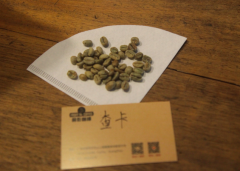The difference between Red Cherry and Lim and their respective Flavor characteristics of African Bean-Yejasuefei
[red cherry]
The main producing areas of Ethiopia are Yegashafi, Sidamo, Punga Forest, Lekanti, Ken Bata, Irubab, Hara, Lim. Yegashafi is a small town in Ethiopia and one of the highest coffee producing areas in the world, with an elevation of 1700-2100 meters above sea level. It is foggy all the year round, with a gentle breeze and cool and humid air. During the harvest season, the Ethiopian Coffee Trading Company will go to town to buy coffee beans collected by farmers and eventually sell them under the brand name "Yega Xuefei". In order to pursue high-quality fruit, implement the "Red Cherry Program", picking 100% all-red fruit by hand, so that coffee farmers pay more attention to the process of selecting beans, and the price of these coffee is relatively high.
Using the exquisite sun method, after screening the available coffee cherries, put the coffee fruit in the elevated shed for sun drying, isolate the contact with the ground, prevent the miscellaneous smell of soil, and create an extremely clean fruit flavor. after more than two weeks of sun exposure, the dark brown coffee fruit is stored professionally, waiting for the whole flavor to be ripe, and the sweetness increases.
Yejia Xuefei body variety is a local native species, small grain species, the appearance is more round, the bean body is very small, mostly between 14-15 mesh. Yejiaxuefei red cherry G1 raw bean color is yellow and green, is a typical sun-cured coffee color, the particles are uniform and full, there are few defective beans.
Flavor: strong fruit aroma, with thick dried fruit, Brin, strawberry, lemon, sweet as honey in the middle, chocolate at the end, not strong in the mouth, medium thickness, no obvious sour taste, like fruit black tea.
[Lim]
The output of coffee in Lim producing area is low, and it is mainly exported to Europe and the United States. It is not easy to buy in China in the past, but it is very popular in Europe and America, and its fame is second only to Yega Xuefei. Coffee varieties are native to Ethiopia (Heirloom), and local coffee farmers grow them in a 100% organic way. The soil is metamorphic (Vertisols) soil, planted between 1850 and 1900 meters above sea level.
Lim Limu production area is mainly washed beans, the taste is milder than that of Sidamo, its body is thin, often with citrus characteristics, floral and citrus performance is also inferior to Yega and Sidamo, but with a hint of grass and cocoa, as well as sandalwood, but not as famous as coffee from Sidamo or Yega Chuefei, but it also produces coffee beans with many flavor characteristics.
The use of water washing treatment, the use of water washing and fermentation methods to remove the peel, pulp and mucous membrane, the introduction of an endless supply of live water. During the treatment, the fermented beans are put into the pool and passed back and forth, using the friction of the beans and the power of running water to wash the coffee beans until smooth and clean. After washing, the coffee beans are still wrapped in the pericarp with a moisture content of 50%. They must be dried so that the moisture content is reduced to 12%, otherwise they will continue to ferment, become moldy and rotten, and then dry in the sun, although it will take 3 weeks. The flavor is excellent and very popular.

Important Notice :
前街咖啡 FrontStreet Coffee has moved to new addredd:
FrontStreet Coffee Address: 315,Donghua East Road,GuangZhou
Tel:020 38364473
- Prev

Rosa Village matches Chaka VS Panamanian Pokuet with butterflies, all of which are Rosa blend flavor.
Some time ago, we entered a lot of beans from Rosa Village, including gold mark, red mark and Chaka. Many friends ask the editor that it is also a rose summer match, so what's the difference between Rose Summer Village Chaka and Panamanian Flower Butterfly? Raw bean information Gesha Village CoffeeEstate CHAKA Rose Xia Village Chaka batch production area: Banchi Maggie altitude: 1900-2100m Variety: Gori
- Next

Introduction of coffee flavor characteristics and double washing of coffee treatment in Burundi (Heart of Africa)
Burundi the Heart of Africa is located on top of the steep East African Rift Valley with complex terrain. More than 800000 of Burundian families depend on coffee cultivation for their livelihood, mostly on small-scale coffee plantations, planted at intervals from other crops, without mechanization. Coffee grows on mountains between 1400 and 1700 meters above sea level. Most of the varieties of coffee trees are bourbon and its varieties.
Related
- Detailed explanation of Jadeite planting Land in Panamanian Jadeite Manor introduction to the grading system of Jadeite competitive bidding, Red bid, Green bid and Rose Summer
- Story of Coffee planting in Brenka region of Costa Rica Stonehenge Manor anaerobic heavy honey treatment of flavor mouth
- What's on the barrel of Blue Mountain Coffee beans?
- Can American coffee also pull flowers? How to use hot American style to pull out a good-looking pattern?
- Can you make a cold extract with coffee beans? What is the right proportion for cold-extracted coffee formula?
- Indonesian PWN Gold Mandrine Coffee Origin Features Flavor How to Chong? Mandolin coffee is American.
- A brief introduction to the flavor characteristics of Brazilian yellow bourbon coffee beans
- What is the effect of different water quality on the flavor of cold-extracted coffee? What kind of water is best for brewing coffee?
- Why do you think of Rose Summer whenever you mention Panamanian coffee?
- Introduction to the characteristics of authentic blue mountain coffee bean producing areas? What is the CIB Coffee Authority in Jamaica?

